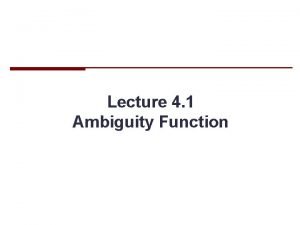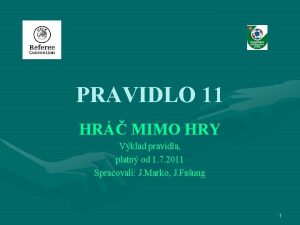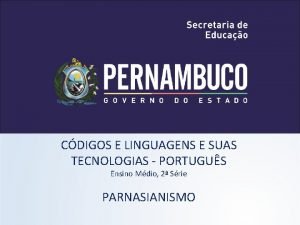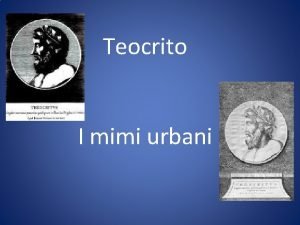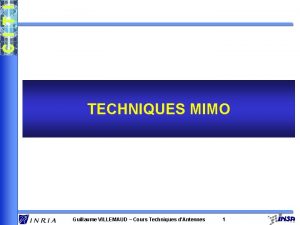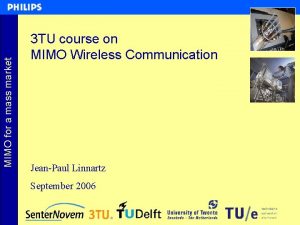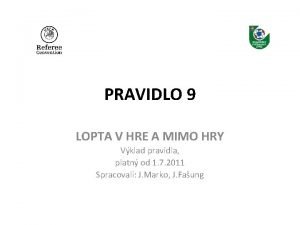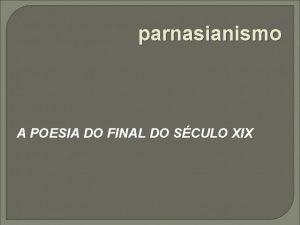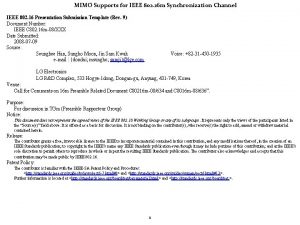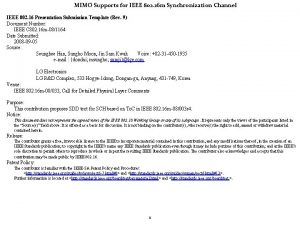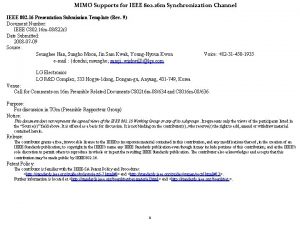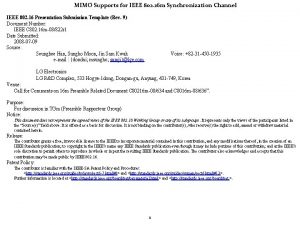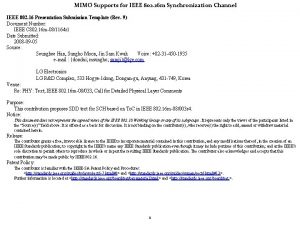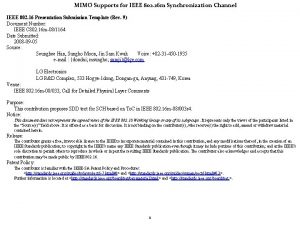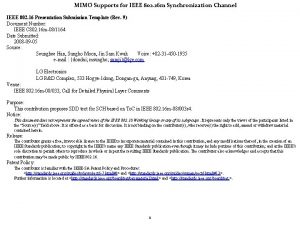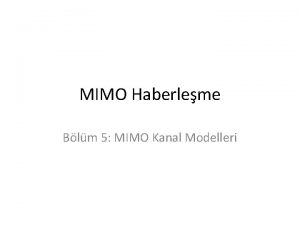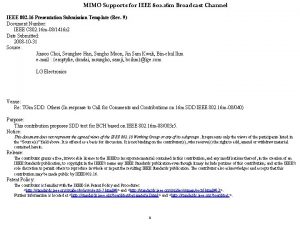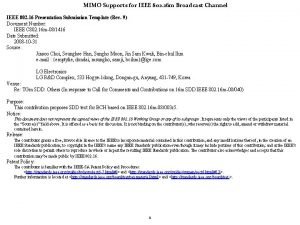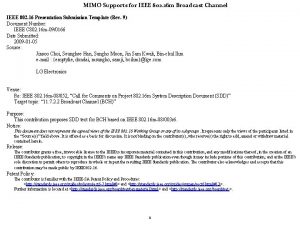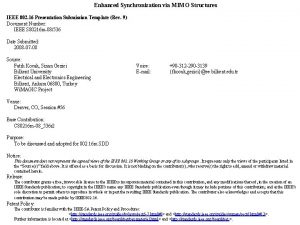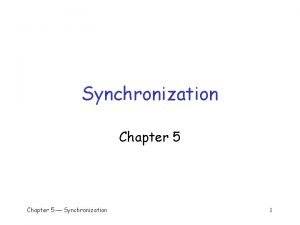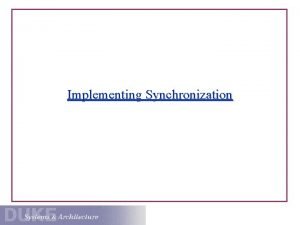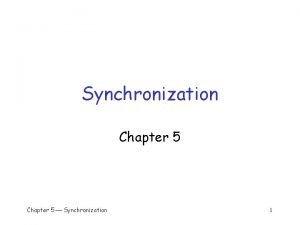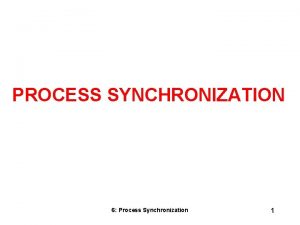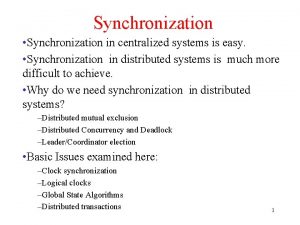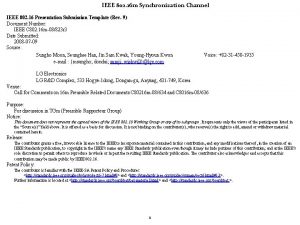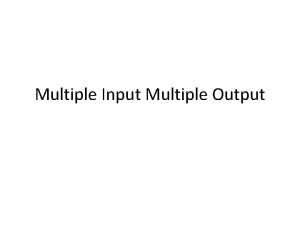MIMO Supports for IEEE 802 16 m Synchronization





















- Slides: 21

MIMO Supports for IEEE 802. 16 m Synchronization Channel IEEE 802. 16 Presentation Submission Template (Rev. 9) Document Number: IEEE C 802. 16 m-08/1164 Date Submitted: 2008 -09 -05 Source: Seunghee Han, Sungho Moon, Jin Sam Kwak Voice: +82 -31 -450 -1935 e-mail : {dondai; msungho; samji}@lge. com LG Electronics LG R&D Complex, 533 Hogye-1 dong, Dongan-gu, Anyang, 431 -749, Korea Venue: IEEE 802. 16 m-08/033, Call for Detailed Physical Layer Comments Purpose: This contribution proposes SDD text for SCH based on To. C in IEEE 802. 16 m-08/003 r 4. Notice: This document does not represent the agreed views of the IEEE 802. 16 Working Group or any of its subgroups. It represents only the views of the participants listed in the “Source(s)” field above. It is offered as a basis for discussion. It is not binding on the contributor(s), who reserve(s) the right to add, amend or withdraw material contained herein. Release: The contributor grants a free, irrevocable license to the IEEE to incorporate material contained in this contribution, and any modifications thereof, in the creation of an IEEE Standards publication; to copyright in the IEEE’s name any IEEE Standards publication even though it may include portions of this contribution; and at the IEEE’s sole discretion to permit others to reproduce in whole or in part the resulting IEEE Standards publication. The contributor also acknowledges and accepts that this contribution may be made public by IEEE 802. 16. Patent Policy: The contributor is familiar with the IEEE-SA Patent Policy and Procedures: <http: //standards. ieee. org/guides/bylaws/sect 6 -7. html#6> and <http: //standards. ieee. org/guides/opman/sect 6. html#6. 3>. Further information is located at <http: //standards. ieee. org/board/pat-material. html> and <http: //standards. ieee. org/board/pat >. 1

MIMO Supports for IEEE 802. 16 m Synchronization Channel 2

Contents • MIMO Support Options • Comparisons of MIMO Options (CDD and FSTD) – Simulation environments – Cell ID detection error (AWGN, TU 6 120 km/h) – Beamforming effect in CDD – Convergence time – Frequency reuse • Summary • Text Proposals for 16 m SDD • Annexes 3

MIMO Supports • Description in the SDD – MIMO support is achieved by transmitting SCH subcarriers from known antennas. Antennas are: • Cyclic delay diversity (with antenna specific delay values) CDD • Interleaved either within a symbol (multiple antennas can transmit within a single symbol but on distinct subcarriers) FSTD • Across frames (only one antenna transmits in each symbol) TSTD • Or some combination – Actual approach is FFS. • Considerations – TSTD has problems in the convergence time with low 4

Comparisons of MIMO Options (CDD and FSTD) • Commonalities – Multi-antenna transmission schemes for 16 m SCH – Distinguishable channel responses for each antenna Possible for CE – Support of various channel conditions • High mobility, Large delay spread, etc • CDD – Spatial diversity with MS-transparent Tx. D on the number of antennas can be achievable. – Larger spreading gain with longer preamble sequence 5

Cell Search Procedure and Simulation Environments • Major Parameters (Detailed in Annex A) – Search duration : 5 ms (coarse timing synchronization only for one SCH) – Multi-antenna transmission: CDD (1/4*Tu shifts for 2 Tx, 1/8*Tu shifts for 4 Tx), FSTD (Localized type) – System bandwidth: 5 MHz – Carrier frequency offset: random within ± 3 ppm @ 2. 5 GHz carrier frequency – Number of cell IDs: 256 – Sequence length: 212/(frequency reuse) for CDD, 212/(frequency reuse)/(# of Tx antennas) for FSTD – Randomly generated BPSK signals (not optimized about PAPR and x-correlation) – Cell ID detection: ML hypotheses by non-coherent detection – # of cells: 1, 2, 3 <cell. A(desired cell): 0 d. B, cell. B: -6 d. B, cell. C: -6 d. B> • Correct Detection Probability – Probability to choose a BS which received power is within 3 d. B of the BS with the highest received power 6

Cell ID Detector • Full Correlator in Frequency Domain – The correlation profiles are calculated coherently for entire sequence length. – Since there always exists timing error (particularly large error after coarse timing sync step) and frequency selectivity in practical situation, it doesn’t work. • Partial Correlator in Frequency Domain – The block-wise correlation profiles are calculated in order to reduce timing error and frequency selectivity. • For intra-blocks, coherent summation • For inter-blocks, non-coherent summation • Differential Correlator in Frequency Domain – To reduce timing error and frequency selectivity. 7

Cell ID Detector (cont’d) • Observations – Full correlator is not feasible. – The performance for partial correlator depends on the size of blocks. • It needs to optimize the parameters. – Different correlator works well. • The differential correlator is deployed for evaluations. 8

Cell ID Detection Error (AWGN) • 3 ppm FO, Practical timing/freq sync, # of cells=1 – Both CDD and FSTD work well. 9

• Cell ID Detection Error (AWGN) (cont’d) 3 ppm FO, Practical timing/freq sync, # of cells=3 – CDD is better than FSTD due to interference randomization. – For CDD, • Good interference randomization between cells – For FSTD, • ~0. 6 d. B SNR loss to CDD for 2 Tx @1% error rate • Severe degradation by ~2. 9 d. B SNR to CDD for 4 Tx @ 1% error rate 10

Beamforming effect in CDD • 3 ppm FO, Practical timing/freq sync, # – Not significant impact of cells=1 of frequency selectivity • No Coverage Hole – No coverage hole has been found for both CDD and FSTD. due to the beamforming in different subcarriers • Constructive subcarriers can be used to maintain the cell-ID detection performance • Impact of beamforming steerlike CDD in a certain Do. A varies in different subcarriers • The overall energies can be maintained. (Annex C) 11

• Cell ID Detection Error (TU 6, 120 km/h) 3 ppm FO, Practical timing/freq sync – 4 Tx is better than 2 Tx due to spatial diversity gain. – CDD is better than FSTD due to frequency diversity gain @ 1% error rate. • by ~0. 5 d. B for 2 Tx • by ~0. 6 d. B for 4 Tx 12

Convergence Time • Definition – Time interval for cell ID detection error to be less than 1% • Observation – # of cells • The inter-cell interference increases a convergence time. – # of transmission antennas • Multi-antenna transmission is necessary to reduce the 13 convergence time.

Frequency Reuse in SCH • Pros and Cons – Decease in interference from other cells – Reduced sequence length (Poor x-correlation property) • Single-Cell Environment – Reuse 1 is always better than Reuse 3 regardless of CDD and FSTD due to reduced sequence lengths. 14

Frequency Reuse in SCH (cont’d) • Multi-Cell Environment – High SNR region (> -10 d. B) • Reuse 1 is better than reuse 3 due to the sequence lengths. • No gain in finding a sector ID due to absence of frequency reuse information – Low SNR region (< -10 d. B) • Reuse 3 is better than reuse 1 due to the reduced interference. – Multiple SCH combining is needed for the reliable performance. • Multiple SCH Combining – # of combined symbols = 5 – Reuse 1 is better than reuse 3 even in the low SNR region. – With the symbol combining, the x-correlation property is more dominant than interference. – FSTD has the same trend regarding frequency reuse. 15

Summary • The CDD transmission of SCH has better performance in terms of the cell ID detection error than FSTD. • The proposed CDD transmission shows reasonable convergence times even in multicell scenarios. • With the symbol combining, a SCH transmission with reuse 1 is better than that with reuse 3 due to the larger sequence length. 16

Text Proposal for IEEE 802. 16 m SDD ======= Start of text proposal for C 80216 m-08/003 r 4======== [Replace the whole section 11. 7. 2. 1. 2. 5 with the following texts] 11. 7. 2. 1. 2. 5 MIMO support and channel estimation Figure xx shows the MIMO support in IEEE 802. 16 m synchronization channel (SCH). Each antenna transmits a cyclic delayed symbol with antenna-specific delay values for IEEE 802. 16 m MSs to perform full-band channel estimation for each antenna in the whole SCH bandwidth. The number of BS antennas supported for MIMO channel measurements is FFS, depending on the requirements of other 16 m SDD content, such as DL MIMO and interference mitigation. Figure xx. Multi-antenna transmission for IEEE 802. 16 m synchronization channel ========= End of text proposal =============== 17

Annex A : Simulation Environments • Simulation Parameters – Carrier frequency: 2. 5 GHz – System bandwidth: 5 MHz – Sampling factor: 28/25 – Sampling frequency: 5. 6 MHz – Subcarrier spacing: 10. 9375 k. Hz – FFT size: 512 – CP length: 1/8*Tu, where Tu is effective OFDM symbol duration – Number of used subcarriers: 424 – Number of guard subcarriers: 88 – Carrier frequency offset: random within 0 ppm and ± 3 ppm – Frame configuration: All 18 DL signals, 5 ms periodicity

Annex A : Simulation Environments (cont’d) • Simulation Descriptions – Number of cell IDs: 256 – Other data channel modeling: Randomly generated QPSK signals – Sequence length for Sync channel: 212 for CDD, 212/(# of Tx antennas) for FSTD All antennas transmit the same sequences. – Sequence type for Sync channel: Randomly generated BPSK signals (not optimized about PAPR and x-correlation) – # of cells: 1, 2, 3 <cell. A(desired cell): 0 d. B, cell. B: -6 d. B, cell. C: -6 d. B> • All signals from each cell are arrived with same absolute times at MS side. – Channel model: AWGN, 19 TU 6 (120 km/h)

Annex B : Differential Detector • Received signal at k-th subcarrier (assuming non-repeated signals) • In AWGN, – λ: wavelength, d: antenna spacing 20

• Annex C : Beamforming Effect in CDD The overall energies can be maintained. 21
 Bridges from 802.x to 802.y
Bridges from 802.x to 802.y Bridges from 802.x to 802.y
Bridges from 802.x to 802.y Ieee 802 3 compliance
Ieee 802 3 compliance Wlan standards
Wlan standards Arquitetura ieee 802
Arquitetura ieee 802 El 802
El 802 Ieee 802 standard
Ieee 802 standard Ieee 802 bluetooth
Ieee 802 bluetooth 802 ieee
802 ieee Ieee 802
Ieee 802 Ieee 802 family
Ieee 802 family Mimo
Mimo Postavenie mimo hry
Postavenie mimo hry Mackenzie) não caracteriza a estética parnasiana:
Mackenzie) não caracteriza a estética parnasiana: La mula de memo
La mula de memo Amore di cinisca
Amore di cinisca Mimo
Mimo Cours mimo
Cours mimo Mimo for dummies
Mimo for dummies Lopta mimo hry
Lopta mimo hry Vaso chinês estranho mimo aquele vaso vi o
Vaso chinês estranho mimo aquele vaso vi o Deming chain reaction
Deming chain reaction











